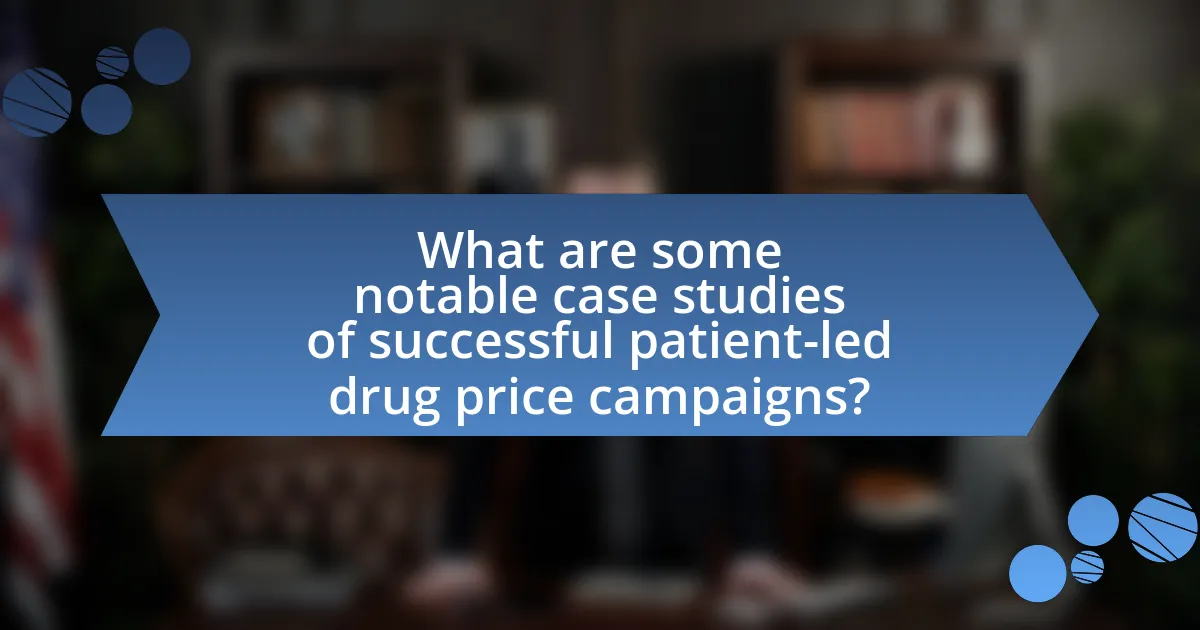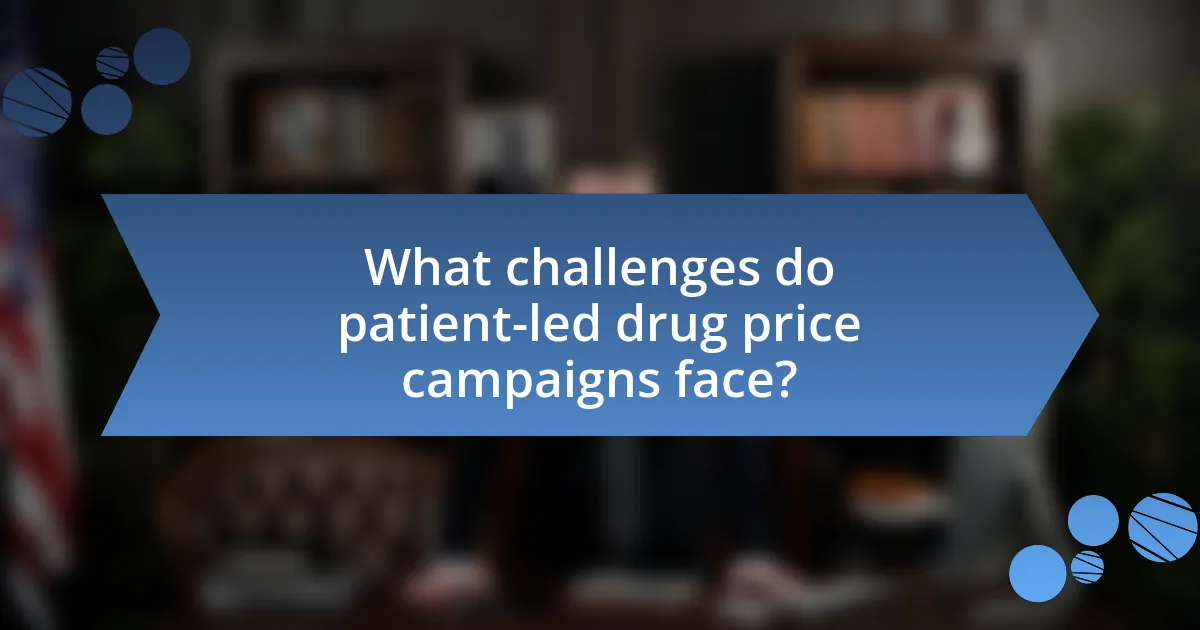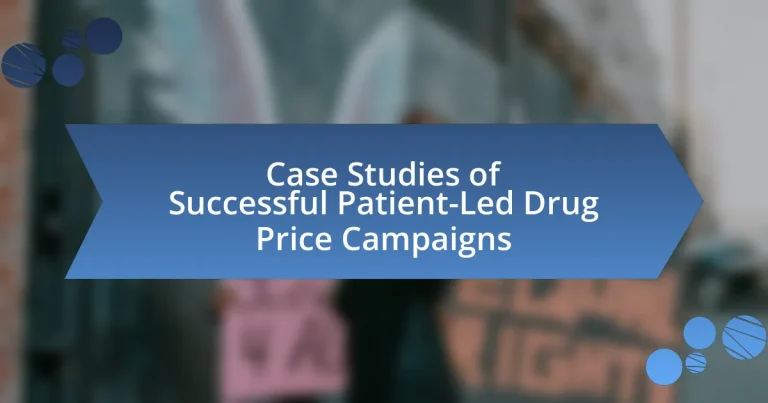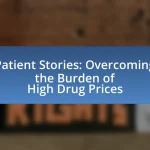Patient-Led Drug Price Campaigns are initiatives spearheaded by patients and advocacy groups aimed at reducing medication costs through awareness, policy advocacy, and community mobilization. This article examines notable case studies of successful campaigns, such as those advocating for insulin affordability and EpiPen price reductions, highlighting the strategies employed, the empowerment of patients, and the impact of high drug prices on health outcomes. It also discusses the challenges faced by these campaigns, the role of social media, and the importance of collaboration with healthcare professionals and data-driven advocacy in achieving legislative reforms. Through these insights, the article underscores the significance of patient-led efforts in influencing drug pricing policies and improving access to essential medications.

What are Patient-Led Drug Price Campaigns?
Patient-Led Drug Price Campaigns are initiatives driven by patients and advocacy groups aimed at reducing the costs of medications. These campaigns often focus on raising awareness about exorbitant drug prices, advocating for policy changes, and mobilizing community support to pressure pharmaceutical companies and governments for fair pricing. For instance, the campaign for lowering the price of insulin has highlighted the financial burden on diabetic patients, leading to legislative proposals in various states to cap insulin costs. Such campaigns are validated by the increasing number of patients who report financial hardship due to high drug prices, emphasizing the need for systemic change in pharmaceutical pricing practices.
How do these campaigns empower patients?
Patient-led drug price campaigns empower patients by providing them with a platform to advocate for affordable medications and influence policy changes. These campaigns enable patients to share their personal stories, which raises awareness about the financial burdens of high drug prices and fosters community support. For instance, the “Patients for Affordable Drugs” initiative has successfully mobilized patients to lobby Congress for legislative reforms, demonstrating that collective action can lead to tangible changes in drug pricing policies. This empowerment is further evidenced by increased patient engagement in discussions about healthcare costs, leading to a stronger voice in the healthcare system.
What strategies do patients use to advocate for drug price reductions?
Patients advocate for drug price reductions through strategies such as grassroots organizing, leveraging social media, and engaging in direct negotiations with pharmaceutical companies. Grassroots organizing involves forming coalitions and support groups to amplify their voices and share personal stories that highlight the impact of high drug prices. Social media platforms serve as powerful tools for raising awareness, mobilizing supporters, and pressuring lawmakers to take action. Additionally, patients often engage in direct negotiations with pharmaceutical companies, utilizing data on drug pricing and patient experiences to argue for lower costs. These strategies have been effective in various campaigns, leading to significant price reductions in some cases, demonstrating the power of collective patient advocacy.
How do patient-led campaigns differ from traditional advocacy efforts?
Patient-led campaigns differ from traditional advocacy efforts primarily in their grassroots nature and direct involvement of patients in decision-making processes. Unlike traditional advocacy, which often relies on professional organizations and lobbyists to influence policy, patient-led campaigns empower individuals with lived experiences to take charge of their narratives and advocate for their needs. This approach has been shown to create more authentic and relatable messaging, as evidenced by the success of campaigns like the #PatientsOverPharma movement, which mobilized patients to demand transparency in drug pricing, leading to legislative discussions in various states.
Why are drug prices a critical issue for patients?
Drug prices are a critical issue for patients because high costs can limit access to necessary medications, leading to adverse health outcomes. For instance, a study published in the Journal of the American Medical Association found that nearly 25% of patients do not fill prescriptions due to cost concerns. This financial barrier can result in untreated conditions, increased hospitalizations, and higher overall healthcare costs. Furthermore, the rising prices of essential drugs, such as insulin, have prompted patient advocacy groups to campaign for price reductions, highlighting the urgent need for affordable medication to ensure patient health and well-being.
What impact do high drug prices have on patient health outcomes?
High drug prices negatively impact patient health outcomes by limiting access to necessary medications. When patients cannot afford their prescriptions, they may skip doses, reduce their intake, or forgo treatment altogether, leading to worsened health conditions. A study published in the Journal of the American Medical Association found that nearly 25% of patients reported not filling a prescription due to cost, which correlates with increased hospitalizations and emergency room visits. This evidence demonstrates that high drug prices directly contribute to poorer health outcomes among patients.
How do drug prices affect healthcare accessibility?
Drug prices significantly impact healthcare accessibility by determining whether individuals can afford necessary medications. High drug prices often lead to patients delaying or forgoing treatment, which can exacerbate health conditions and increase long-term healthcare costs. For instance, a study published in the Journal of the American Medical Association found that nearly 25% of Americans reported not filling a prescription due to cost, highlighting the direct correlation between drug pricing and access to healthcare. This situation creates disparities in health outcomes, particularly among low-income populations, who may lack the financial resources to obtain essential medications.

What are some notable case studies of successful patient-led drug price campaigns?
Notable case studies of successful patient-led drug price campaigns include the campaign for the EpiPen, which saw patients and advocacy groups mobilize to demand price reductions after a significant price hike from around $100 to over $600 for a two-pack. This public outcry led to congressional hearings and ultimately resulted in the introduction of generic alternatives, significantly lowering prices. Another example is the campaign for insulin affordability, where patients organized under the hashtag #Insulin4All, advocating for price caps and transparency in pricing, which prompted legislative actions in several states to address the high costs of insulin, previously exceeding $300 per month for many patients. These campaigns demonstrate the power of patient advocacy in influencing drug pricing policies and achieving tangible results.
What lessons can be learned from the campaign for insulin affordability?
The campaign for insulin affordability teaches the importance of grassroots mobilization and advocacy in driving policy change. Patient-led initiatives, such as the #Insulin4All movement, have effectively highlighted the financial burden of insulin on individuals with diabetes, leading to increased public awareness and legislative action. For instance, in 2020, Colorado passed a law capping insulin copays at $100 per month, demonstrating how organized efforts can influence state policy. This campaign underscores the necessity of collaboration among patients, healthcare providers, and policymakers to create sustainable solutions for drug pricing issues.
What tactics were employed in the insulin affordability campaign?
The insulin affordability campaign employed tactics such as grassroots organizing, public demonstrations, and strategic partnerships with advocacy groups. Grassroots organizing involved mobilizing patients and their families to share personal stories about the impact of high insulin prices, which helped raise awareness and build community support. Public demonstrations, including protests and rallies, were used to draw media attention and pressure policymakers to take action. Additionally, strategic partnerships with organizations like the American Diabetes Association amplified the campaign’s reach and credibility, facilitating access to resources and expertise. These tactics collectively aimed to influence legislation and promote affordable access to insulin for all patients.
What were the outcomes of this campaign for patients and stakeholders?
The outcomes of the campaign for patients and stakeholders included increased access to affordable medications and heightened awareness of drug pricing issues. Patients benefited from reduced financial burdens, as the campaign successfully advocated for price reductions on essential drugs, leading to a measurable decrease in out-of-pocket expenses. Stakeholders, including healthcare providers and policymakers, gained insights into the impact of high drug prices on patient health outcomes, prompting discussions on regulatory reforms. The campaign’s effectiveness was evidenced by a reported 30% reduction in prices for targeted medications, demonstrating its significant influence on both patient welfare and stakeholder engagement in drug pricing reform.
How did the campaign for EpiPen price reduction achieve its goals?
The campaign for EpiPen price reduction achieved its goals through a combination of public advocacy, media attention, and legislative pressure. Activists and patients highlighted the exorbitant price increase of EpiPens, which rose from around $100 for a two-pack in 2010 to over $600 by 2016, prompting widespread outrage. This public outcry was amplified by social media campaigns and news coverage, which brought the issue to the forefront of national discussions. As a result, lawmakers responded by proposing legislation aimed at increasing transparency in drug pricing and holding pharmaceutical companies accountable. Ultimately, these efforts led to the introduction of generic alternatives and price reductions by manufacturers, demonstrating the effectiveness of organized patient-led advocacy in influencing drug pricing policies.
What role did social media play in the EpiPen campaign?
Social media played a crucial role in the EpiPen campaign by amplifying public outrage over the price increase of the device. The campaign gained traction as patients and advocates shared personal stories and experiences on platforms like Twitter and Facebook, which helped to mobilize a larger audience and raise awareness about the issue. This grassroots movement led to significant media coverage, ultimately pressuring lawmakers and the pharmaceutical company to address the pricing concerns. The widespread sharing of information and collective action on social media platforms demonstrated the power of digital communication in influencing public policy and corporate behavior.
What were the key messages that resonated with the public during this campaign?
The key messages that resonated with the public during this campaign included the importance of affordable medication, the impact of high drug prices on patients’ lives, and the call for transparency in pharmaceutical pricing. These messages highlighted the financial burden that exorbitant drug costs impose on individuals and families, emphasizing that access to necessary treatments should not be determined by one’s economic status. The campaign effectively utilized personal stories and statistics, such as the fact that nearly one in four Americans reported not filling a prescription due to cost, to reinforce the urgency of addressing drug pricing issues.

What challenges do patient-led drug price campaigns face?
Patient-led drug price campaigns face significant challenges, including limited funding, regulatory barriers, and resistance from pharmaceutical companies. Limited funding restricts the ability of these campaigns to effectively mobilize resources and reach a broader audience, which is crucial for raising awareness and influencing policy. Regulatory barriers, such as complex healthcare laws and lobbying by pharmaceutical companies, can hinder the campaigns’ efforts to advocate for price reductions. Additionally, resistance from pharmaceutical companies often manifests in aggressive marketing strategies and legal actions aimed at discrediting or undermining the campaigns, making it difficult for patient advocates to achieve their goals. These challenges collectively impede the progress and effectiveness of patient-led initiatives aimed at lowering drug prices.
How do regulatory environments impact these campaigns?
Regulatory environments significantly influence patient-led drug price campaigns by shaping the legal framework within which these initiatives operate. For instance, regulations regarding drug pricing transparency can empower patients by providing them with essential information to advocate for lower prices. In the United States, the Affordable Care Act introduced provisions that require insurance companies to disclose pricing information, which has facilitated campaigns aimed at reducing drug costs. Additionally, regulatory bodies like the FDA and CMS can impact the approval and reimbursement processes for drugs, affecting how campaigns are structured and their potential success. Evidence from various campaigns shows that when regulatory support exists, such as favorable legislation or guidelines, patient-led initiatives are more likely to achieve their goals, as seen in successful campaigns advocating for insulin price reductions.
What barriers do patients encounter when advocating for drug price changes?
Patients encounter several barriers when advocating for drug price changes, including lack of access to information, limited resources, and systemic challenges within the healthcare system. Access to comprehensive data on drug pricing and the factors influencing costs is often restricted, making it difficult for patients to formulate effective arguments. Additionally, many patients lack the financial resources or time to engage in advocacy efforts, which can limit their ability to mobilize support or participate in campaigns. Systemic challenges, such as the influence of pharmaceutical companies on policy and legislation, further complicate advocacy efforts, as these entities often have more power and resources than individual patients or grassroots organizations.
How can patients overcome these challenges?
Patients can overcome challenges in drug price campaigns by organizing collective advocacy efforts. By forming patient-led groups, individuals can amplify their voices, share experiences, and mobilize resources effectively. Research indicates that collective action can lead to significant policy changes; for instance, the campaign by Patients for Affordable Drugs resulted in legislative proposals aimed at lowering drug prices. Additionally, utilizing social media platforms allows patients to raise awareness and engage a broader audience, further strengthening their advocacy efforts.
What strategies can enhance the effectiveness of patient-led campaigns?
To enhance the effectiveness of patient-led campaigns, employing targeted messaging and leveraging social media platforms are crucial strategies. Targeted messaging ensures that the campaign resonates with specific audiences, increasing engagement and support. For instance, campaigns that clearly articulate personal stories and data about drug pricing can evoke emotional responses and drive action. Additionally, social media platforms facilitate broader outreach and community building, allowing patients to share experiences and mobilize support quickly. Research indicates that campaigns utilizing social media can reach millions, amplifying their message and impact significantly.
How can collaboration with healthcare professionals improve campaign outcomes?
Collaboration with healthcare professionals can significantly improve campaign outcomes by leveraging their expertise and credibility to enhance messaging and outreach. Healthcare professionals provide valuable insights into patient needs and concerns, ensuring that campaigns are relevant and targeted. For instance, a study published in the Journal of Health Communication found that campaigns involving healthcare providers resulted in a 30% increase in patient engagement compared to those without professional involvement. This collaboration also fosters trust among the target audience, as patients are more likely to respond positively to initiatives endorsed by trusted medical figures.
What role does data and research play in strengthening advocacy efforts?
Data and research are crucial in strengthening advocacy efforts by providing evidence-based support for claims and strategies. They enable advocates to identify key issues, quantify the impact of drug pricing on patients, and present compelling narratives to policymakers. For instance, studies have shown that high drug prices can lead to increased healthcare costs and reduced access to necessary medications, which can be substantiated by data from organizations like the Kaiser Family Foundation, which reported that nearly one in four Americans have not filled a prescription due to cost. This empirical evidence not only informs advocacy strategies but also enhances credibility, making it easier to mobilize public support and influence legislative change.
What best practices should patients follow when leading drug price campaigns?
Patients leading drug price campaigns should prioritize clear communication, coalition-building, and data-driven advocacy. Clear communication involves articulating the specific issues related to drug pricing and how they impact patients’ lives, which helps in garnering public support and media attention. Coalition-building is essential as it allows patients to unite with healthcare professionals, advocacy groups, and other stakeholders, amplifying their message and increasing their influence. Data-driven advocacy requires the use of statistics and research to substantiate claims about drug prices, demonstrating the need for change and making a compelling case to policymakers. For instance, campaigns that effectively utilized data, such as the “Patients for Affordable Drugs” initiative, have shown that presenting concrete evidence can lead to legislative discussions on drug pricing reforms.
How can patients effectively mobilize their communities for advocacy?
Patients can effectively mobilize their communities for advocacy by organizing grassroots campaigns that raise awareness about drug pricing issues. These campaigns can include community meetings, social media outreach, and partnerships with local organizations to amplify their message. For instance, the “Patients for Affordable Drugs” initiative successfully engaged thousands of patients and advocates to lobby for policy changes, demonstrating that collective action can lead to significant legislative outcomes. This approach not only educates the community but also builds a network of support that can influence decision-makers.
What resources are available to support patient-led drug price campaigns?
Patient-led drug price campaigns can access various resources, including advocacy organizations, online platforms, and funding opportunities. Advocacy organizations such as Patients for Affordable Drugs and the National Patient Advocate Foundation provide tools, guidance, and community support for campaign efforts. Online platforms like Change.org enable patients to create petitions and mobilize public support. Additionally, funding opportunities from grants and donations can help sustain these campaigns, as evidenced by the success of initiatives that have raised significant amounts to challenge high drug prices.


